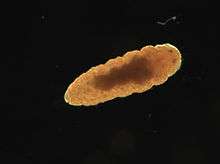Dinophilus taeniatus
Dinophilus taeniatus is a small annelid worm which lives in tidal pools. It is 1.5 – 2.5 mm long and about 150 µm wide, orange in colour, with two distinct dark pigmented eyes on its prostomium. The anterior part of prostomium has four large and many small bristles and sensory cilia. The trunk consist of 11 rings where the first nine rings are distinctly separate. The ventral trunk is densely covered with cilia. It is widely distributed around the UK coast, from the Irish Sea through to the Barents Sea.[2] [3]
| Dinophilus taeniatus | |
|---|---|
 | |
| Scientific classification | |
| Kingdom: | Animalia |
| Phylum: | Annelida |
| Class: | Polychaeta |
| Order: | incertae sedis |
| Family: | Dinophilidae |
| Genus: | Dinophilus |
| Species: | D. taeniatus |
| Binomial name | |
| Dinophilus taeniatus Harmer, 1889[1] | |
Ecology
Free swimming Dinophilus taeniatus are found October to June lives in tidal pools with the diatom Enteromorpha spp. and Ulva lactuca. Numbers peak March to April and decline with rising temperature and lesser diatom abundances, the decline is due to death of reproducing adults and obligatory encystment of juveniles.[2][3]
Distribution
It is found in the North Sea (Scottish and English east coast, Belgian coast, and Heligoland), English Channel (Plymouth, Roscoff), Irish Sea (North Wales, Isle of Man), Atlantic (Irish coasts, Faroe Islands), Spanish coast (Valencia), Baltic (Kiel Bay), Skagerrak (Swedish west coast), and the White and Barents Sea.[3]
Reproduction
Females produces a maximum of 4 cocoons with up to 16 eggs each in a sequence of 2–3 months. Excysted worms mature, feed and reproduce sexually until May.[3]
Systematics
References
- Harmer, Sidney F, Proceedings of the Cambridge Philosophical Society, 6(6):1, 1889
- Jennings, Jb; Pj Donworth (December 1986). "Observations on the Life-Cycle and Nutrition of Dinophilus-Taeniatus Harmer 1889 (annelida, Polychaeta)". Ophelia. 25 (3): 119–137. doi:10.1080/00785326.1986.10429744. ISSN 0078-5326.
- Westheide, W. Polychaetes: Interstitial Families. Synopsis of the British Fauna. 2008. Field Studies Council. Retrieved 2013-08-24.